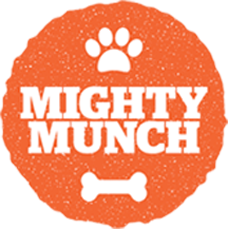Hip dysplasia is very common among old dogs, and catching it early allows you to make changes that make life more comfortable for your pup, whether it’s starting them on joint supplements to relieve pain or installing ramps in your home to protect their hips from stairs.
The problem is, the signs of hip dysplasia in dogs aren’t always easy to identify. In this guide, we’ll help you understand how to know if your dog has hip dysplasia. We’ll explore the common hip dysplasia dog symptoms and what you can do to treat the pain that comes with this condition.
Whether your dog has hip dysplasia or you simply want to do everything you can to protect their joint health, Mighty Munch’s joint supplement for dogs is the perfect place to start. Backed by vets and made from natural, potent ingredients, they’re the best hip and joint supplement for dogs in Australia!
It’s never too soon to start protecting your dog’s joint with Mighty Munch’s best joint supplement for dogs - they’re safe and suitable for dogs of all breeds, ages, and sizes. So, invest in your dog’s wellness, and in the meantime, join us here to learn about dog hip dysplasia signs and symptoms.
What is Hip Dysplasia?
Before we explain how to know if your dog has hip dysplasia, let’s take a look at the condition itself. Hip dysplasia is a common orthopedic condition affecting dogs, characterised by abnormal development or malformation of the hip joint.
Definition and Causes
Hip dysplasia occurs when the hip joint does not develop properly, resulting in a mismatch between the ball and socket of the hip. This malformation can lead to instability, inflammation, and degeneration of the joint over time.
While the exact cause of hip dysplasia is not always clear, it is believed to result from a combination of genetic and environmental factors. Large and giant breeds, such as Labrador Retrievers, German Shepherds, and Great Danes, are particularly susceptible.
Other factors like rapid growth, improper nutrition, excessive exercise, and obesity can exacerbate the condition or contribute to its development in genetically predisposed dogs.
Anatomy of the Canine Hip Joint
To understand hip dysplasia, it's essential to grasp the anatomy of the canine hip joint. The hip joint is a ball-and-socket joint where the rounded head of the femur (thigh bone) fits into the acetabulum, a socket in the pelvis.
This arrangement allows for smooth movement and weight-bearing during various activities, such as walking, running, and jumping. But, In dogs with hip dysplasia, the hip joint may be lax or loose due to abnormal development, leading to instability and increased wear and tear on the joint surfaces.
Over time, this can result in inflammation, pain, and degenerative changes, such as osteoarthritis. But what are the early dog hip dysplasia signs? Next up, we’ll explore how to know if your dog has hip dysplasia, and what you can do about it.
How to Know If Your Dog Has Hip Dysplasia: Signs and Symptoms, Diagnosis, and More
Recognising the hip dysplasia dog symptoms as early as possible is essential for starting your pup on the right course of treatment for dog hip and joint health and managing their symptoms. Here’s what to look out for when it comes to dog hip dysplasia signs and symptoms.
Understanding Breed Predisposition
Certain dog breeds are more predisposed to hip dysplasia due to genetic factors. Large and giant breeds, including Labrador Retrievers, German Shepherds, Golden Retrievers, Great Danes, and Rottweilers, are among those commonly affected.
Also, breeds with a history of selective breeding for specific traits may exhibit a higher prevalence of hip dysplasia. Being aware of your dog's breed predisposition can help you monitor them closely for signs of this condition.
Signs and Symptoms to Watch For
Learning how to tell if your dog has joint pain or discomfort isn’t always easy, because your dog can’t always communicate how they’re feeling. Make sure you’re looking out for the key dog hip dysplasia signs, including:
- Decreased activity and a reluctance to engage in exercise
- Lameness, limping, or favouring one or both hind legs
- Difficulty standing up from a lying position, climbing stairs, or jumping on furniture
- Stiffness or reluctance to move, especially after periods of rest
- Audible clicking or popping sounds when moving their hips
If you do notice these hip dysplasia dog symptoms and signs, it’s a good idea to contact your vet - they can go through the steps of diagnosing your dog and explaining the best course of action.
Professional Diagnostic Methods
Understanding how to know if your dog has hip dysplasia isn’t easy, but your vet can help. Formal diagnosis of hip dysplasia usually involves a combination of a physical exam with special palpation techniques, imaging studies like X-rays, and sometimes also lab tests.
Managing Your Pet’s Condition if You Notice the Dog Signs of Hip Dysplasia
If you start to see the dog hip dysplasia signs we discussed above, or if your vet finds hip dysplasia dog symptoms, what happens next? Learning that your dog has hip dysplasia can be a lot to deal with, but luckily, some treatment options can make a real difference.
Treatment Options
Hip dysplasia dog treatment aims to alleviate pain, improve joint function, improve hip dysplasia dog symptoms, and slow the progression of degenerative changes. Depending on the severity of your dog's condition, treatment options may include:
- Medications like nonsteroidal anti-inflammatory drugs (NSAIDs) and pain relievers
- Physical therapy, including therapeutic exercises, massage, and hydrotherapy
- Surgical intervention and hip replacements in more severe cases of hip dysplasia
After you identify the signs of hip dysplasia in dogs, your vet can help you understand your treatment options and come up with a plan for treating your pup’s hip dysplasia, based on their specific hip dysplasia dog symptoms and how much the condition is affecting your pup’s health.
Lifestyle Modifications
Making adjustments to your dog's lifestyle can help minimise discomfort and reduce the daily impact of hip dysplasia. Maintaining a healthy weight is crucial for reducing stress on the hip joints. If your dog is overweight or obese, work with your vet to develop a weight management plan.
Incorporate low-impact exercises and activities such as swimming or gentle leash walking into your dog's exercise routine to promote joint flexibility and muscle strength without exacerbating discomfort. Regular, low-impact exercise also helps to keep your pup in a healthy weight range.
There are also different modifications you can make in your home to keep your dog comfortable. Provide your pup with a supportive and orthopedically designed bed to alleviate pressure on their joints while resting, add ramps over stairs and steps, and elevate your dog’s food and water bowls.
Nutritional Support
Nutrition plays a crucial role in managing hip dysplasia and supporting your pup’s overall joint health. The best dog food for joint health is a balanced and nutritionally complete diet formulated for their age, size, and activity level.
Supplement Recommendations
Should I give my dog joint supplements for hip dysplasia? Yes - if you see the dog signs of hip dysplasia, starting your dog on high-quality dog supplements can improve their joint health and reduce the pain and discomfort that comes with hip dysplasia.
Wondering what to give old dogs for joint pain? Choose diets rich in high-quality proteins, omega-3 fatty acids, and joint-supportive nutrients such as glucosamine, chondroitin sulphate, and MSM (methylsulfonylmethane) to support cartilage health and reduce inflammation.
If you’re not sure how to choose the right supplements for your dog, you’re already halfway there! Mighty Munch’s hip and joint supplement contains key ingredients (and no added fillers, artificial flavours, or anything nasty) designed to both protect and soothe your dog’s joints.
Do dog hip and joint supplements work even if your pup hasn’t shown dog signs of hip dysplasia yet? Yes - key ingredients like glucosamine increase joint fluid and cartilage, which prevents further joint degradation and slows the onset of hip dysplasia.
Fish oil for dogs is another great supplement for joint health, as the omega-3 fatty acids contain powerful anti-inflammatory properties that can combat joint inflammation and pain. Mighty Munch fish oil is made from premium marine sources and exceeds Australia’s pet health standards.
As well as having the best product for dog joint pain and hip dysplasia, we also have premium dog probiotics (the best supplements for dog gut health and a healthy immune system!) and a dog collagen supplement - perfect for when your dog’s natural collagen production starts to decline.
Not sure whether collagen vs glucosamine supplements are best for your pup? Why not try both?! The best collagen for dogs keeps your dog’s coat and skin shiny and healthy, and complements glucosamine by strengthening your dog’s nails.
Monitoring and Follow-Up
Regular monitoring and follow-ups with your vet are essential for evaluating your dog's response to treatment and adjusting their management plan as needed. Keep an eye out for any changes in your dog's mobility or behaviour, and talk to your vet if you have any concerns.
Final Thoughts on the Dog Hip Dysplasia Signs and Symptoms
Learning to recognise the signs of hip dysplasia in dogs is essential for any pup parent - it allows you to start treating your dog’s symptoms from the moment they begin to experience pain and discomfort.
With lifestyle modifications, gentle exercise, and potent joint supplements from Mighty Munch, you can reduce inflammation and improve your dog’s joint mobility, extending their best years and keeping your pup active and healthy as they age.
Don’t wait until it’s too late - invest in your dog’s health with premium joint supplements from Mighty Munch!


